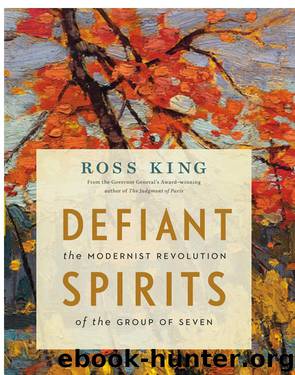Defiant Spirits by Ross King

Author:Ross King
Language: eng
Format: epub
Tags: Art / CanadianBiography & Autobiography / Artists
Publisher: D & M Publishers
Published: 2010-09-24T04:00:00+00:00
8 THE DWELLER OF THE THRESHOLD
MORALE AT “Camp Horror” had improved since Lawren Harris arrived in time for the riot in the hot summer of 1916. There was now a YMCA canteen selling cigarettes, and a wooden shed, known as “The Strand,” that showed silent films. But the base was still, for many recruits, a place of “dirt, dust, and loneliness.” 1
Most recruits spent only three weeks before shipping overseas. Harris, though, stayed at Camp Borden for twice as long as the average recruit. He served as a musketry instructor, using his artistic talents to devise European cityscapes and realistic moving targets—“Fritzies that popped up and disappeared”—on which the recruits could practise their marksmanship.2 By the end of 1916 he was transferred to Toronto, where he gave instruction at the District School of Musketry, a rifle range improvised on the campus of the University of Toronto. The university had taken on the appearance of a military encampment, with tents sprouting on the lawns, soldiers and cadets everywhere, and the Royal Flying School occupying parts of Convocation Hall and Wycliffe College. In the newly built Hart House, wounded and shell-shocked soldiers were treated with hydrotherapy and massage.
If Harris was unable to forget the war, his new posting at least allowed him to paint in the evenings and during his periods of leave. He even managed to exhibit a work at the OSA exhibition in 1917, a daringly vibrant canvas called (in an allusion to that favourite artistic tarte à la crème) Decorative Landscape. Another of his remarkable snow-and-fir compositions, it was the most adventurously decorative work he had ever produced. Painted around the same time that Thomson worked on The Jack Pine, it showed the blue silhouettes of pine trees in vivid relief against a sky painted with dabs of primrose yellow. In the foreground of this clangorous interplay of complementaries were swirls of blue and purple snow. Charlesworth dismissed it as a “garish poster.” 3
Although living in Toronto and able to paint, Harris was deeply troubled through much of 1917, owing partly to his despair over the war and the death of Tom Thomson. He was also suffering from a spiritual malaise that made him doubt his artistic direction as well as his purpose in life. In the midst of his crisis he wrote a letter to MacDonald, describing his ailment in curiously abstract terms. He claimed he “felt curiously shifty as if in an element that was making great sport of me.” He found himself torn between “alluring impermanencies” and “even-more-attractive-at-the-time permanent things and nothings,” and he told MacDonald he did not feel “soul-steadied” and that he had “built everything . . . on sand.” 4
One of the few other glimpses into his restless psychological condition can be found in some of the poems he began writing around this time. One of them, called “The Age,” expressed his gloomy attitude about society’s obsession with the material and the immediate at the expense of the eternal: “This is the age of the soul’s degradation, / Of tossing into the sun’s light / The dross and slime of life.
Download
This site does not store any files on its server. We only index and link to content provided by other sites. Please contact the content providers to delete copyright contents if any and email us, we'll remove relevant links or contents immediately.
| Africa | Americas |
| Arctic & Antarctica | Asia |
| Australia & Oceania | Europe |
| Middle East | Russia |
| United States | World |
| Ancient Civilizations | Military |
| Historical Study & Educational Resources |
Cat's cradle by Kurt Vonnegut(15128)
Pimp by Iceberg Slim(14273)
4 3 2 1: A Novel by Paul Auster(12245)
Underground: A Human History of the Worlds Beneath Our Feet by Will Hunt(11992)
The Radium Girls by Kate Moore(11887)
Wiseguy by Nicholas Pileggi(5627)
Perfect Rhythm by Jae(5296)
American History Stories, Volume III (Yesterday's Classics) by Pratt Mara L(5234)
The Fire Next Time by James Baldwin(5217)
Paper Towns by Green John(5057)
Pale Blue Dot by Carl Sagan(4880)
A Higher Loyalty: Truth, Lies, and Leadership by James Comey(4813)
The Mayflower and the Pilgrims' New World by Nathaniel Philbrick(4393)
The Doomsday Machine by Daniel Ellsberg(4388)
Killers of the Flower Moon: The Osage Murders and the Birth of the FBI by David Grann(4363)
The Sympathizer by Viet Thanh Nguyen(4278)
Too Much and Not the Mood by Durga Chew-Bose(4247)
The Borden Murders by Sarah Miller(4211)
Sticky Fingers by Joe Hagan(4079)
